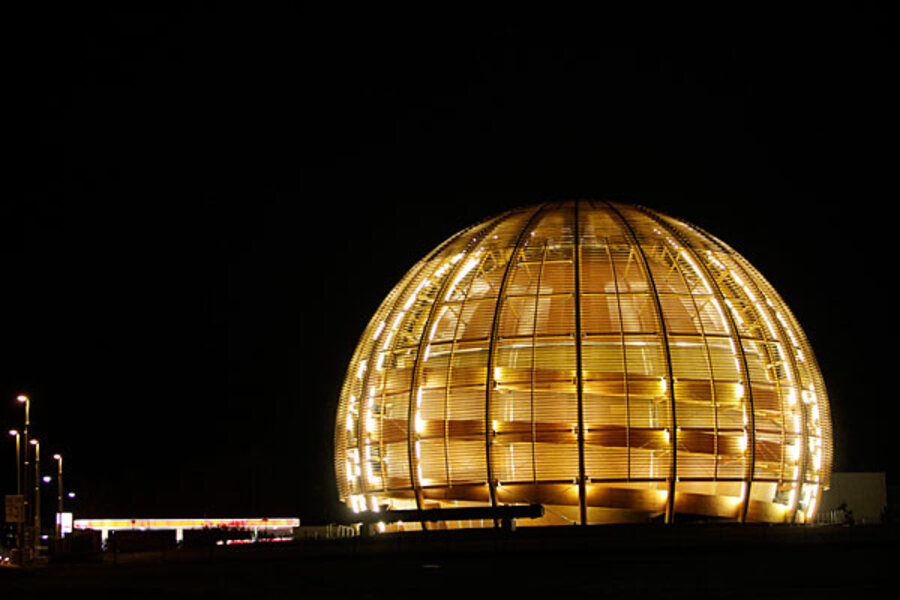Neutrino particle traveling faster than light? Two ways it could rewrite physics.
Loading...
Scientists at the European Organization for Nuclear Research (CERN) say they have measured tiny subatomic particles traveling faster than light.
The difference in speeds is tiny – some 60 billionths of a second over a distance of 454 miles. Even so, if other labs can reproduce the effect, physicists envision one of two far-reaching outcomes.
In one, the CERN team's results could bolster quantum theories of gravity – the last of nature's four fundamental forces scientists are trying to fit under the umbrella of quantum physics. Theories of quantum gravity suggest that at sufficiently high energies, particles can appear to travel faster than light because they traverse extra dimensions of space.
One example is string theory, which posits a universe of many more dimensions than the four humans experience.
"If you have a theory in which there is more than one way to get from A to B, maybe you can have a shortcut and have the appearance of traveling faster than the speed of light," says Stephen Parke, who heads the theoretical physics department at the Fermi National Accelerator Laboratory in Batavia, Ill.
The alternative? A pillar of modern physics – Einstein's theory of special relativity, in which the speed of light is a particle's absolute speed limit – could take its first serious hit. Perhaps not flat wrong, but only a piece of a more complete picture.
The CERN team's observation "is a pretty revolutionary result. There will be a lot of people who are skeptical about it in the community, and rightfully so," Dr. Parke says. "Other people need to redo this experiment and see whether they get similar results."
The particles involved are neutrinos, fiendishly difficult to work with because they rarely interact with matter. Thus particle accelerators must produce them in vast quantities in order to spot rare interactions with detectors when they do occur.
They come in three types, and the experiment the team was running – dubbed OPERA – was designed to track neutrinos as they morph from one type to another as they travel.
The team generated beams of neutrinos at CERN, which straddles the French-Swiss border. They aimed the beams at detectors in a cavern at Gran Sasso, Italy, some 450 miles away. With a set of detectors at CERN, and another at Gran Sasso, the team was measuring the neutrinos' travel time between the two. That's when the discrepancy began to emerge.
Rumors of the results have been circulating in the physics community for several weeks, Parke notes. But word leaked more broadly. A draft research paper describing the experiment, results, and efforts to rule out glitches is expected to be posted on the Internet Thursday night. In addition, OPERA scientists are holding a talk at CERN Friday to shed more light on what the team found and the process it underwent to eliminate sources of error in its results.
"We tried to find all possible explanations for this," said Antonio Ereditato, a member of the OPERA collaboration in an interview with the BBC. After hunting for all the mistakes, large and small, the team could think of, it didn't find any.
"Then you say, 'Well, now I'm forced to go out and ask the community to scrutinize this,' " he said.
Ironically, similar hints that neutrinos might be thumbing their noses at Albert Einstein appeared four years ago at Fermilab. Its MINOS experiment is similar to OPERA. MINOS generates neutrino beams at Batavia and sends them through the Earth to detectors in a mine in northern Minnesota some 450 miles away.
In 2007, Fermilab scientists reported detecting neutrinos arriving slightly sooner than they would if traveling at the speed of light. But the difference was so small that it was not statistically significant. The team posted its results, but didn't sound a fanfare.
Parke says the team is upgrading its equipment to improve the precision of its measurements. If all goes well, Fermilab could provide a reality check on the OPERA results in about three years.
Confirmation – or a "maybe not" – could come sooner from Japan, which has a similar, though shorter, long-baseline neutrino experiment. Even though the facility was affected by this year's tsunami-generating earthquake, researchers suggest that the lab's archives may hold the data needed to compare with OPERA's.
If that's the case, a second opinion on particles that appear to outrace light might be only months away.





